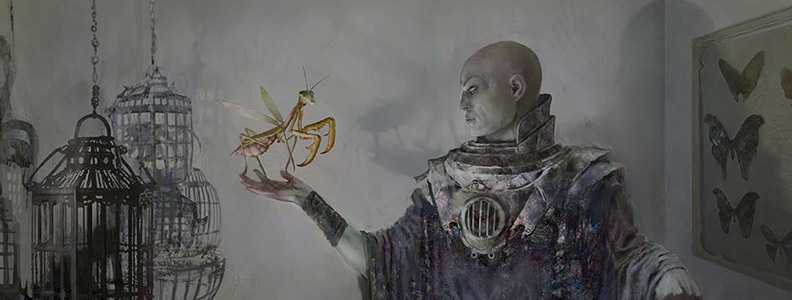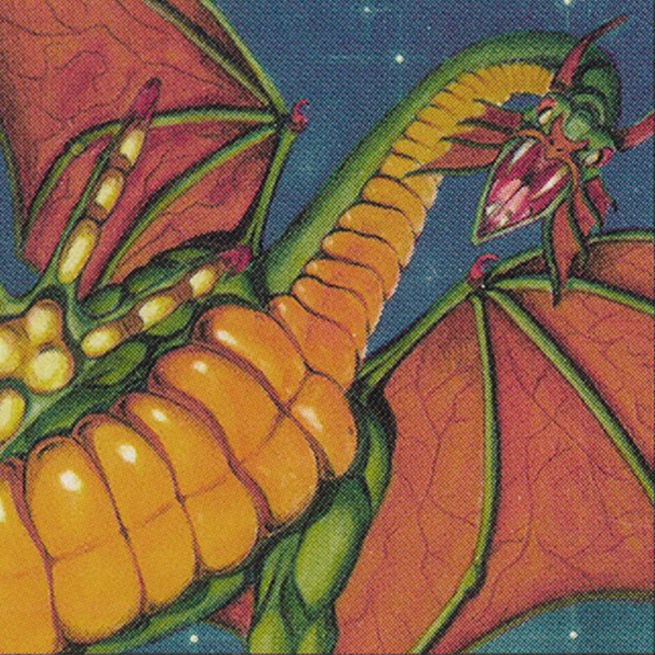Welcome to our weekly interview series, There's No Magic Without Art!
This week we had the pleasure of talking with artist Nils Hamm, who lives in Germany, and since the set Future Sight has illustrated over 150 Magic cards, including iconic ones like Delver of Secrets, Phantasmal Image and Baleful Strix.
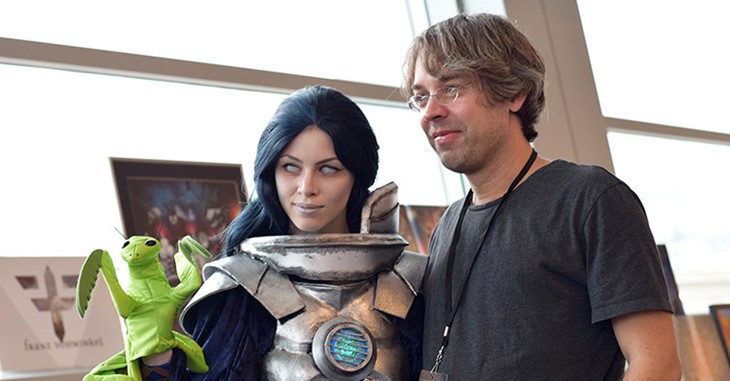
How did you become an artist?
Since Kindergarten i liked to draw, and in my youth I was big into reading comics; later, I had the vague idea of becoming a comic artist, and some years later, when i got in touch with fantasy art, through cover artworks by Frazetta and other fantasy artists, I decided that was what I wanted to do.
I studied graphic design & Illustration, and though I did not learn a lot on a more technical level, I had good teachers who opened my horizon regarding art, composition and such, and I really started appreciating non-fantasy art (which before I just did not respond to much), and that helped me learn about what makes a good drawing a good painting.
In my last year studying, I visited some of my old art idols in the USA, which was a fantastic adventure; one of them was Rick Berry, and his very unorthodox approach to painting was another eye opener, and that still resonates in me until today.
And how did you start working on Magic?
Dawn Murin got me on board for Hecatomb, a horror card game that WOTC did back then (2004 or 2005 I guess). The game eventually stopped, but meanwhile Jeremy Jarvis, MTG Art Director then, had seen my stuff and wanted to work with me as well. I am still super thankful; before that I often heard my style was too strange, "people would not get it" and so on.
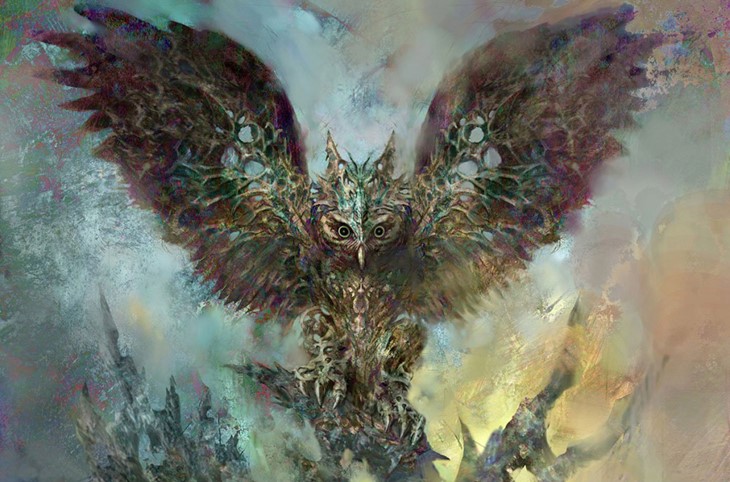
What was your first card?
I worked both on Minions Murmur's and Henchfiend of Ukkor, the set was Future Sight.
What Medium(s) do you work with? Can you give us a brief description of your painting process for Magic?
When working traditionally, I mostly use oils on boards, lately I am experimenting more with different media as well, tints, watercolors, and I like to mix different media too.
When working digitally, I usually paint digitally over traditional abstract surfaces that I scanned in. That way, the scanned surface gives me many parts with shapes and textures that can help to give the digital painting a traditional look, something that I like. The part I enjoy the most is "finding" the image in that chaotic abstract surface in the beginning. Photoshop is fantastic for that, as you can manipulate the whole painting in an instant via layer settings for example.
It's like switching through color clouds of rough ideas. That can be very exciting and a rather intuitive process, and it is usually my gut that tells me when one direction has potential; it can be certain colors, shapes or a mix of both. If I have to paint a Dragon for example it can be a batch of texture that looks kind of spiky, another looks like a cool snake or a dragon's neck, and then I go in and try to bring it together somehow.
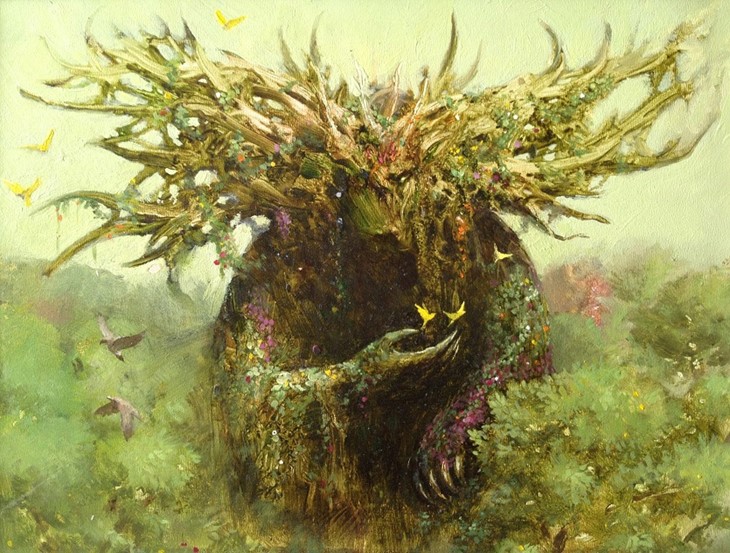
The looser the art direction, the better this approach works. Some images, usually more complex ones with many characters interacting, require more planning though. These days it has become more important that certain specific design elements like architecture, certain clothing, etc, are implemented to clearly show which set the card belongs to.
Do you paint these abstract surfaces purely from instinct?
The abstract surfaces sometimes are created kind of accidentally when I am not happy with a non-finished painting and paint over it. At other times they come out of experiments with different colors and tools; for example, if you apply acrylic colors thinned with water onto a oil color surface, it builds isolated drops or islands of color. Like oil floating on water, only that in this case the water flows on oil. If the acrylic color dries, you get very interesting surfaces.
What makes for an interesting art description?
As described above it suits me best if there are as little restrictions as possible.
For me the best description sounds like: Nils, draw us a witch.
Or: Nils, we need a demon. Give us the most demonlike demon you can come up with.
We are not interested in the background, keep that foggy, no special architecture, just focus on that one single creature.
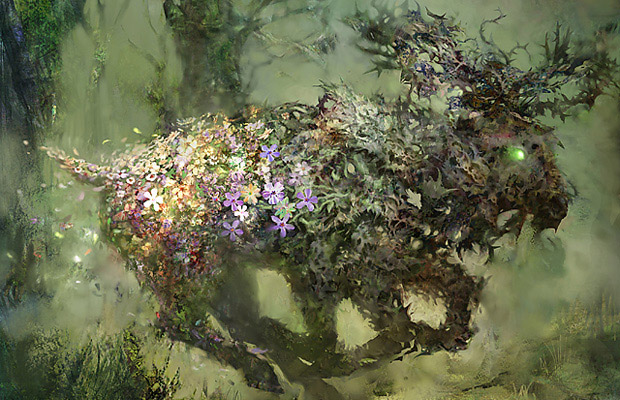
Or: paint us a enchanted forest.
Very simple, archetypal images are what inspire me most. I think I could enjoy just painting wizards for the rest of my life.
Oh, I would like even more if the description had the following note: "Be experimental in your style."
A great card for me was Eyes Everywhere, as Cynthia Sheppard, who was the Art Director, gave me very free hands on it.
What were the most challenging cards to paint and conceptualize?
Bartizan Bats was tricky, as I had the idea to build a big skull into the composition that is not visible at first sight. I did that instead with Rotting Mastodon but in the previous card, the image needed more components, the bats, the Tower, Ravnica architecture, and so on.
Can you share with the process behind Delver of Secrets?
Delver was a very nice card to do; here again I had a lot of freedom in designing the figure and his suit (as well as the laboratory), and I tried to give him a dignified look; he might be doing spooky stuff and experiments, but I do not see him as an evil character (I don't know if there is any lore behind him in the MTG universe), he is just totally into what he is doing.
And maybe he has delved into his topics too deep....Besides that, I liked telling a little story through the double-sided card. That was even more fun with Ludevic's Test Subject, another double-sided card I did in that set.
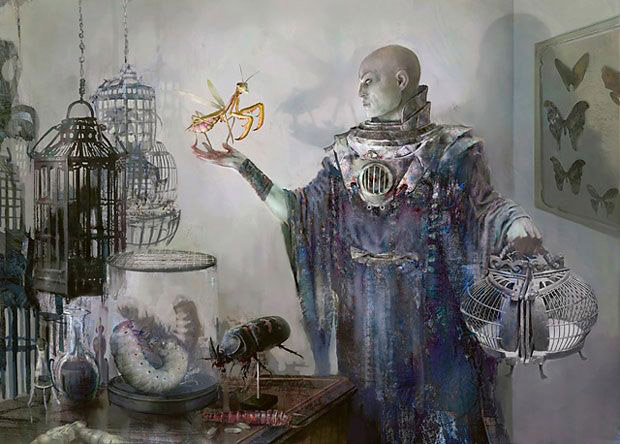
We saw three new pieces from you on the latest Ravnica Allegiance expansion. I really like the composition for Eyes Everywhere, a card we already touched on.
Eyes Everywhere I enjoyed a lot, also as I did it as a big traditional painting. I used an older, unfinished painting as a base, very much as described above, and painted over that. I had a rough idea and composition but could build many parts of it on the fly.
Since the card was a spell showing a rather surreal scene, I not only could show all different kind of eyes, but also mix different styles. Some of the eyes merely consist of an outer circle done with a crayon and a pupil, while other eyes are painted more naturalistic.
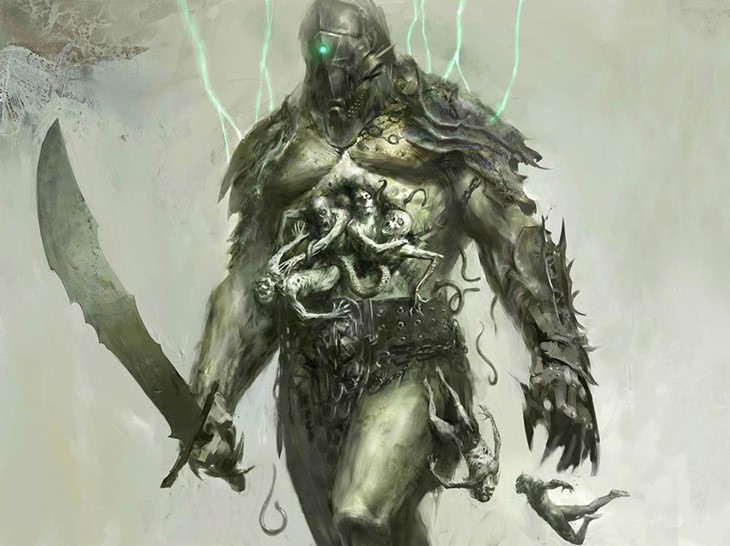
Of the work you made for Magic, can you name your favorite cards?
I always liked Chancellor of the Spires; Rosemane Centaur i like, too. Also Gilder Bairn.
One of my all-time favorite cards by other MTG artists is Phantom Tiger by Seb McKinnon, which blew me away the first time someone showed it to me at a tournament.
I am a big fan of his art and the poetic, more abstract qualities he brings into the game. Such a fresh wind!
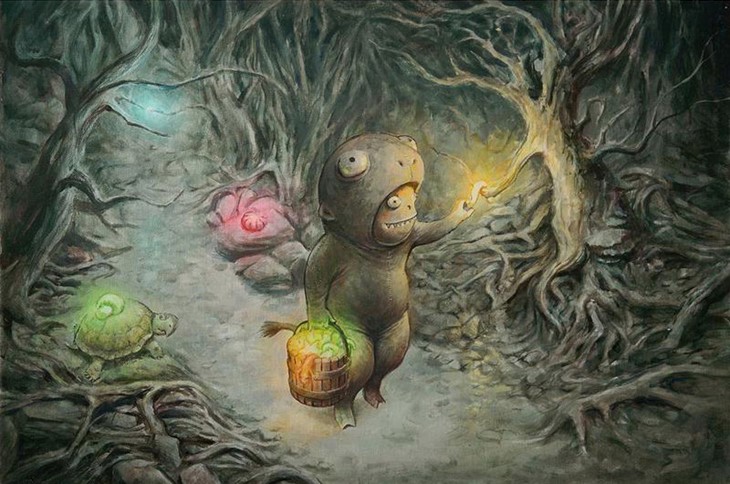
Any Magic related story you’d like to share?
A Magic related story that comes to my mind is that I once fell asleep while drawing on a Magic GP. It was on my first day at GP Chibain Japan in 2016. I had arrived the day before and had a strong jetlag; after a couple hours of signing and altering it became really hard to keep my eyes open.
I was just about to start drawing a token card for a player, I faded out for a second and woke up, as my hand had dropped and the pen had left a perfect vertical line on the otherwise blank card. I looked around, but no one seemed to have noticed, so I kept drawing and did build the drawing around that vertical line on the card.
